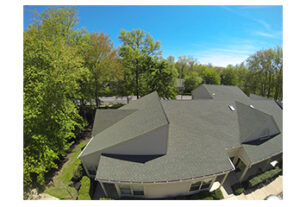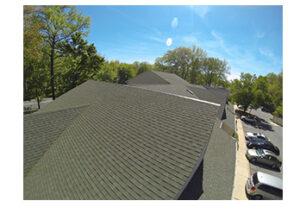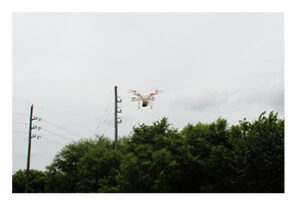Ready to Utilize Drones on the Job? Factors to Consider in Commercial Use
By Kevin Kianka, Operations Manager, Technical Services

Drones are a hot topic in the media these days, whether they are being used to help report the news (such as to show recent flooding in Houston) or whether they are the actual topic of the news (such as when drones impacted the airspace of a jet on its final approach to LaGuardia Airport and led to flight diversions). While the term “drone” is used most often in the media, the official Federal Aviation Administration (FAA) designation is Unmanned Aircraft System (or UAS). Other designations include quadcoptor, unmanned aerial vehicle, and unmanned aerial system.
Regardless of what you call it, the UAS is fast becoming a valuable asset to the architecture, engineering, inspection, real estate and insurance industries. Previously inaccessible areas and views of properties are now obtainable via the use of a UAS. And the control is literally in the user’s hands. A UAS can be utilized to provide documentation of damage and collapses, aerial views, and other images that were previously too costly on small to moderate projects. Now the UAS provides cost effective options that were once unobtainable for the average homeowner or inspector.
However, before you go out and buy a system or hire someone to perform a service using a UAS, there are several factors which must be considered.
First, before you fly, it is imperative that you determine whether you have permission and authorization to fly. If you are going to fly a UAS inside of a building or enclosed space, permission from your client and the property owner/manager will get you started. Note that the industry you are working in may have additional restrictions or requirements. Make sure you check all available resources to determine if there are any restrictions to your indoor use of a UAS.

If you move outside, additional regulations impact you: specifically and most importantly, those regulations which are established by state and federal agencies. In addition to obtaining permission from your client and the property owner, you must determine if the US state you are working in allows the use of a UAS for commercial purposes, as individual states are legislating UAS usage. The commercial use of a UAS in open airspace is further regulated by the FAA. As of the date of this document, such use requires you to obtain FAA Section 333 Exemption for any commercial application; governmental operations have different requirements. (Note: Haag Engineering Co. recently received approval to utilize UAS systems under the FAA Section 333 Exemption. For more information on all we can offer, read the press release here.) The Section 333 exemption comes with additional requirements. To name a few, not only must a FAA-licensed pilot operate the UAS, but s/he must do so from an area that is at least 500’ away from all nonparticipating persons or structures. The pilot may work only over a private or controlled-access property, and the pilot must obtain express permission from the owner.
Once you have determined that you actually have permission to fly, you can analyze and identify the hardware that you’ll need to do the job.
A UAS can vary in cost from several hundred dollars to tens (if not hundreds) of thousands of dollars. Selecting the right UAS is an involved process, and the actual UAS itself is just one piece of the puzzle. Users also need to consider what data they are trying to collect and what they are going to do with that data. Whether you are using a digital camera, FLIR, LIDAR, or other type of apparatus, data acquisition is required to document the view from the UAS. The next and most important piece of the puzzle to define what you are going to do with your data. Are you simply taking pictures? Do you want to take measurements from the data? Do you want to create panoramic images? These are many questions that need to be answered before someone implements the use of a UAS.

In addition, training is crucial. Do not expect to purchase a UAS on Monday and use it on Tuesday. It is best to plan on several days and weeks (if not months) of practice using the hardware and software before utilizing it on a paying project.
Importantly, a UAS will not replace a required workflow; it will only assist you in completing that workflow. Likely, an inspector will still need to access a roof or complete a hands-on inspection of a bridge or apparatus to complete her/his analysis. For example, an aerial image might indicate circular areas of granule loss on an asphalt roof; a crack in an elevated concrete structure; cracking in the pavement of a parking lot; or damage to elevated piping in a facility. However, a hands-on inspection is still required to confirm the severity and extent of any damage captured visually by UAS data. The UAS is merely a tool to assist in that process.
Below are some basic questions that you should ask before you consider using a UAS.
- Does the client allow the use of a UAS?
- Will the property owner/manager/controller allow the use of UAS?
- What data are you trying to collect and what are you going to do with it?
- Can you perform the data processing internally or will a consultant be required?
- If a consultant is required, is s/he qualified to do this work and what will the cost be?
- Will the data meet the accuracy and precision needs for the project?
- Do you (or your consultant) have the data-processing expertise needed to produce reliable and defendable results?
- Will the UAS be operated outdoors?
- Does the city, county and/or state where the services are being performed allow the use of a UAS?
- Do you or your employer have a FAA Section 333 Exemption?
- Does the UAS Operator (Pilot in Charge) hold either an airline transport, commercial, private, recreation or sport pilot certificate from the FAA?
- Will the UAS operate at least 500’ from all nonparticipating persons, vessels, vehicles or structures, unless protected by a barrier?
- Will the UAS operate over private or controlled-access property with permission from the property owner/controller or authorized representative?
Once these are satisfactorily answered, you may be well on your way to using a drone for the first time on the job!

Kevin Kianka, P.E., serves the Director of Operations, based in Haag’s Sugar Land (Houston), TX office and leading Haag Technical Services efforts nationwide, including all services related to 3D Laser Scanning, 3D Modeling, Drones (sUAV’s), GIS, and other advanced technologies. A licensed Professional Engineer in Texas, New Mexico, Colorado, New Jersey, New York, Pennsylvania and Florida, Mr. Kianka obtained a Bachelor of Science in Civil Engineering from Drexel University (Philadelphia, PA) and has over 15 years of experience in the field of Engineering.

